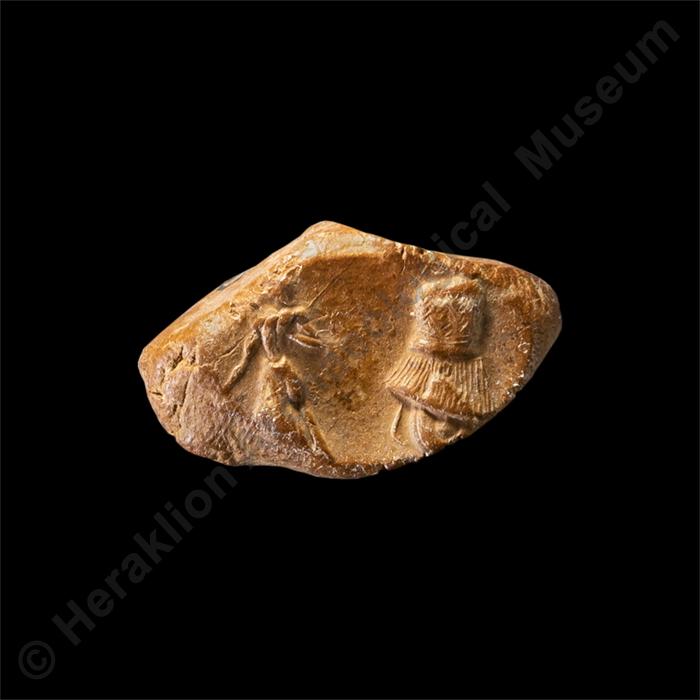Clay sealing with procession of priests
Σ-Τ441-28
Clay
Almost intact, with clear image. Notably, 256 sealings bear the same image, made by the same signet ring
Length: 2 cm. Width: 1.2 cm.
Hagia Triada
Royal Villa, sealing archive
Late Bronze Age, Neopalatial period, Late Minoan IB period:
1500-1450 BC:
Gallery:
VIIICase:
77Exhibition thematic unit:
Late Bronze Age - Neopalatial period (1700-1450 BC). Minoan religion. Palace cultCult scenes
Description
Clay sealing with two men bearing a sacred garment in ceremonial procession to the left. The pair are identically rendered, with shaven head and a single lock hanging to the neck, wearing long, wide hide kilts common in Minoan religious ceremonies. The first man has his right arm bent, hand in front of the chest, holding a staff-shaped emblem with a bent lower end supported on his right shoulder. His body is particularly athletic and well formed, but the depiction with his back to the viewer is quite unnatural. The second man is carrying a sacred garment, the upper half decorated with stacked chevrons and the lower half fringed or pleated. The garment completely covers the man’s body from chin to thighs, concealing his arms. The parallel vertical lines at the right edge of the scene are probably conventional indications of the palatial environment in which the procession is taking place. The processional carrying of a sacred garment, usually accompanied by ceremonial emblems, is frequently depicted in seal-carving and appears to echo actual processions bearing offerings to the deity. The faience models of women’s dresses, found in the Temple Repositories of the palace of Knossos together with the famous Snake Goddesses, support this view. The image on the Agia Triada sealing is associated with the rural procession on the celebrated Harvester Vase found in the same room, as the elderly leader of the farmers is wearing the same fringed robe and carrying a similar staff-shaped emblem. These may be successive episodes of the same religious festival, involving the presentation of the sacred garment to the priest, followed by the blessing of the harvest.Bibliography:
D. Levi, "Le cretule di Haghia Triada", Annuario della Scuola archeologica di Atene 8-9 (1925-26) 131, fig. 141. P. Demargne, "La robe de la déesse minoenne sur un cachet de Mallia", Mélanges d’archéologie et d histoire offerts à Charles Picard à l’occasion de son 65e anniversaire, Revue archéologique 29-30, Paris 1948, vol. I, 284 no. 4, fig. 6. M. Nilsson, The Minoan-Mycenaean Religion and its Survival in Greek Religion, Lund 1950, 156, fig. 62. C. Verlinden, "Nouvelle interprétation du decor incisé sur une double hache en bronze supposé provenir de Voros", in P. Darcque and J.C. Poursat (eds), L’Iconographie Minoenne. Actes de la Table Ronde d’Athenes (21-22 avril 1983), BCH Supplément XI, Athènes 1985, 138, fig. 4. N. Marinatos, Minoan Religion. Ritual, Image and Symbol, Columbia 1993, 137, fig. 103. Corpus der minoischen und mykenischen Siegel II6, 11.Author:
S. M.Photographs' metadata
